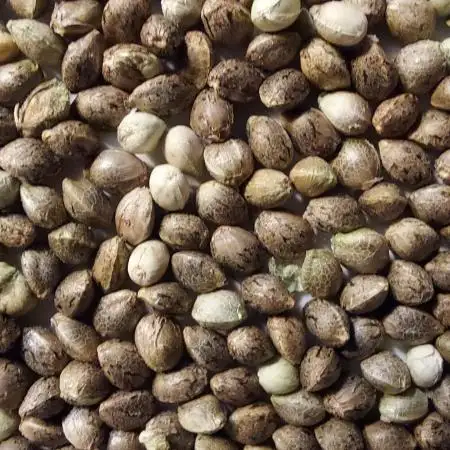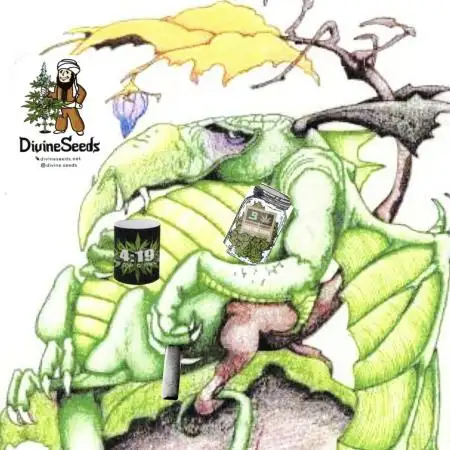The Grow Awards 2026 🏆
Old seeds
DaSofaSurferstarted grow question 6mo ago
Guys please lete know if there is a trick to germinate old seeds. Ive got a bunch of old genétics.. i tried to germinate 3 seeds and went 0 for 3 so "no Bueno" ive heard of mixinh hidrigen peroxide but cant remendar the ratio do if anyone has any tips/trick to gelo germinate it.
Solved
likes
Core_T_Sonanswered grow question 6mo ago
Die Wasserstoffperoxydmischung ist 2ml H2O2 / 1 L Wasser.
Alternativ kann man auch Ackerschachtelhalmextrakt benutzen. Einweichen in 24-26 Grad warmem destilliertem Wasser mit entweder Wasserstoffperoxyd oder Ackerschachtelhalmextrakt bis der Samen auf den Boden sinkt. Dann sofort in vorgewärmtes Medium. Auf keinen Fall unter 24 Grad celsi
ATLien415answered grow question 6mo ago
Yeah, GA is a naturally occuring plant hormone. Cyanide and nicotine and on and on are also naturally occuring. GAs are PGRs in the west, which I presume is relevant. I'm just pointing out that throwing around GAs without getting them naturally is using PGRs with no argument otherwise. I'm also just pointing out that using GAs without also noting that lever's nuance with respect to a hormone map for cannabis is literally just an oopsie, considering the bell curves I mentioned and the relative ratios being the key.........aka you're gonna have a detriment just throwing 100 PPM triacantanol into your mix without adjusting across the entire map/stage........and that is the basics here, not even anything anyone really with a deep understanding would be thinking about. it is guidance that is likely illegal the way you worded it, likely illegal for the need/likely location the OP noted, is a PGR, could go wrong, has incredibile sourcing issues for a leyman, and more.
You may be young on this one, but I recall the days of a certain UFO dude who never existed but somehow built a jet engine decades ago in his garage and claimed he worked on UFOs and sold uranium online and aerogel and the like.... You speak like GAs are fine to play around with. Improper use of GAs can turn a productive lettuce head/shrub into an 11 ft tall lettuce tree with mutations and bitter leaf. Even him, still selling uranium online, has kicked his concentration on his GA blend down by a magnitude...so as to be a mildly responsible adult.
If you want to use GAs and you purchase literal GAs, rather than cannabis or kelp or moringa extracts/ferments, then you're purchasing PGRs and are getting from xcho zaho derrfamy fajj as a random seller on temu or alibaba unless you have a true chemical license or academic need. Just why, when you can do MLE yourself and get GA3 and more....in a ratio that...works for more than breaking dormancy...and is legal in the west?
1 like
Complain
m0useanswered grow question 6mo ago
a lot has to do with the quality of the seed and how it was stored.
Peroxide or scarification fo the shell helps. keeping things clear and sanitized also helps as its likely going to take longer to do basic shit and be week. So the best start it can get helps.
1 like
Complain
00110001001001111Oanswered grow question 6mo ago
with 3% h2o2, you want 1 part h202 2 parts h2o and that will ersult in 1%.
if 35% ... simple algebra still. how do you get 35% to 1%? 1 part 35% to 34 parts water will give a 1/35th concentration from the original 35%, which is 1%. So, the ratio you need depends on starting concentration, obviously. Think there's another common percentage you'll find on pre-packaged h2o2 products. 12%? 1part:11parts ... for 1%
If you have a different target from 1%, still easy to do. Even using 3% should not kill a seed. I've seen allsorts of ratios suggested. The lower the concentration the longer it'll take to sanitize. 1% or even 3% is not a very strong sanitizing agent but can be effective if given long enough to do its job. Flat non porous surfaces need less time than fibrous surfaces.
h2o2 breaks down incredibly fast when exposed to light, fyi. if the h2o2 is important to you, keep it in darkness as best you can.
1 part is your starting solution... the number of parts to add plus that 1 part add up to your denominator. 0.1% target from 3% would be 1/30th concentration, right? so 1 part 3% and "29" parts water. 1:29 and 1+29=30.
if it was 35%.. 0.1% is 1/350th of 35%. 1part : 349 parts.
After you use "al gebra," you must say "allah hu akbar."
1 like
Complain
00110001001001111Oanswered grow question 6mo ago
if it has to do with seed shell being too hard, scoring or h2o2 can h elp a bit by softening or allowing the seed to absorb moisture more easily -- i'd only score it if you absolutely know for sure this (shell is too hard) is the cause of your problem otherwise damaging seed shell may add to the cause of germination failure.
H2o2 can sanitize things, might make seed shell softer, but is not magic. It won't fix a "dead" seed.
Soaking supposedly helps with old seed, but as long as the medium stays moist it really shouldn't make a difference as long as water can be absorbed to start the process and stay moist throughout the germination process and some darkness for taproot are all you need to provide. This doesn't hurt anything as long as you don't soak for too long, so might as well try it with problematic seeds... don't soak more than 24h. The whole float or sink related stuff is nonsense. I've seen a seed sink immediately and it was fine. I don't bother with this anymore, but each to their own. It never made any real difference in my rate of germination, so i don't know how helpful it'd be for this..
I would strongly suggest you keep things simple. you should have near 100% germ rates for viable seeds with a simple routing and all the other sophistications are just a form of masturbation. Old seeds that are inviable happen, and if that's the case there's no raising the seed from the dead. It's done. Some become inviable faster than others (genetic diversity) and sometimes it's the result of or exacerbated by poor storage conditions.
the only thing i ever did beyond the basics that had a real impact was a heat mat. This is less important if your climate is nice and warm, obviously, but keeping substrate at 76-80F at the very least creates more consistency in germination rates. Before i used one i had a wide range from 2-5 days for sprout (direct to substrate method). With the heat mat it's 2-3 days for vast majority and maybe a couple stragglers out of 15-20 batch.
If you know a batch has a low rate, plant a ton of them. Use simple methods. Use a heat mat if in cold climate. Don't be cheap about it.. get one with a soil thermometer. I use a humidity dome just so i can delay '2nd' irrigation. Rather irrigate after sprouting and remove humidity dome when it sprouts. No concern about seed shifting around or drowning a nascent seedling that hasn't broke ground yet. Unless using a huge pot for a tiny seedling, aeration of medium should be fine while doing so.
likes
Complain
Still_Smoqanswered grow question 6mo ago
Once the seed starts to dry out during long term storage, there will be little you can do to germinate it, or keep it viable. All the high tech terminology and chemical use out there won’t restore what has been degraded. There will be a few that survive longer than others, humidity will dictate the length.
1 like
Complain
Ultravioletanswered grow question 6mo ago
Gibberellic acid is a naturally occurring plant hormone, and no adverse effects are expected from its use as a plant growth regulator or seedling dormancy rejuvenation.
GA3 is legally permitted for use in organic production when produced by fermentation and extraction from biological materials. It is used to promote various plant growth processes, including germination, emergence, and fruit development.
However, there are specific regulations regarding the use of pesticides, and GA3 is sometimes classified as a pesticide.
Perfectly legitinate to use it for seeds in my country of origin and is not regulated so long as I dont misuse it. Thank you for your concern ATLien415. Certainly worth remembering to check with your local government regulations, lol
Half of GD community would dissappear overnight given they grow illegaly but hey.
2 likes
Complain
ATLien415answered grow question 6mo ago
Advising people of using GAs without a full expounding is not appropriate IMO. In the West, GAs are de facto PGRs and are regulated incredibly. Getting around this is entirely possible and many of us do, but the manner in which you speak of the phytohormones is very important... Advising dormancy claims or growth claims is how you get snapped on by regulatory agencies, because you are then marketing a PGR. All answers so far are suspect with regards for regulatory guidance and would be illegal to do. A proper guidance here would be to use a handmade MLE or kelp extract.
These are regulated for a reason. Use natural ratios of hormones, these things are bell-curved typically with results and that curve for some ends from like 0.00010%PPM to 0.000011%PPM. Many folks hate PGRs with a passion without understanding that many are just hormones, the improper use without understanding is how we have massive false seeding issues, foxtailing, and generally a reduction in secondary metabolites in commercial crops. Dont be like them. HMU if you want a reference for like a textbook on this type of stuff.
Moringa is like cannabis for hormones for plants, it produces essentially all except some trace, trace stuff you'd gather from ocean water or kelp...
You can do non-medical treatments for the seeds first like scoring, preparing a solution to simulate stomach acid then a bath then rinse, or adding endophytes from somewhere like GrowWithGrease.
1 like
Complain
Ultravioletanswered grow question 6mo ago
While endosperm plays a crucial role in seed viability, it's not the sole determinant of how long a seed will last. Seed longevity is influenced by a combination of factors including the seed's genetic composition, moisture content, storage temperature, and the presence of protective tissues like the seed coat. So if it's been left to bake in the sun for 10 years it's dead as dead can be. Stored in cool dry conditions at perfect temps that's different.
The endosperm, a tissue within seeds, primarily functions to nourish the developing embryo. It acts as a food reserve, storing nutrients like starch, proteins, and lipids that the embryo utilizes for growth. While it's crucial for embryo development, the endosperm itself is also a dynamic tissue that can be influenced by various factors, including plant hormones and environmental signals.
Gibberellins (GAs) are known to promote seed germination and can be used to break dormancy and stimulate the growth of the embryo. They do this by triggering the production of enzymes that break down stored food in the seed, providing energy for the developing embryo. Gibberellins, a class of plant hormones, can promote seed germination by counteracting dormancy-inducing factors and stimulating the processes involved in early seedling growth.
Buy some gibberellic acid.
To mix gibberellic acid (GA3) for plants, you'll typically dissolve the powder in a small amount of alcohol, then dilute it with water to the desired concentration. Around 300ppm to initiate response in a full-grown plant, so I'm not sure what a seed would need for a seedling. If you have many seeds to test I'd try different solutions ppms jist to be safe.
Also worth noting.
The tough outer coat of seeds can delay germination. Hydrogen peroxide softens this layer, allowing water and oxygen to reach the embryo quickly, which activates growth. It's a natural disinfectant, killing bacteria, fungi, and other microorganisms that may hinder germination or damage seedlings. But it won't do shit if it's dormant.
Phytochrome, a light-sensitive pigment, plays a significant role in triggering cannabis seed germination. Phytochromes, particularly phytochrome B, are involved in the light-mediated regulation of germination, with red light generally promoting germination and far-red light inhibiting it.
1 like
Complain
Mr_Weeds_Autosanswered grow question 6mo ago
This is happening to me too. As we speak, I have an abundance of seeds and not enough space to plant them. Germinating old seeds can be hit or miss, but there are a few tricks that can increase your chances. One of the most effective methods is soaking the seeds in a hydrogen peroxide solution. The proper ratio is 1 part 3% hydrogen peroxide to 10 parts water—for example, mix 5 ml of hydrogen peroxide with 50 ml of water. Soak your seeds for 6 to 12 hours to help soften the shell and eliminate any pathogens. After the soak, you can move them into your usual germination setup, like a damp paper towel or peat puck. Another helpful method is to lightly scuff the seed coat with fine sandpaper or an emery board, which helps moisture penetrate older, tougher shells. Temperature plays a big role too—keep them warm, ideally around 78 to 82°F (25 to 28°C). Using a heat mat can make a big difference, especially if your grow area runs on the cooler side. Germinate them in a dark, humid environment like a sealed container with a moist (not soaking) paper towel inside. For an extra boost, you can try soaking the seeds in coconut water diluted at a ratio of 1 part coconut water to 2 parts water, as it contains natural cytokinins that can encourage germination. If you're working with really rare or valuable genetics, a more advanced option is using gibberellic acid (GA3) at 250 to 500 ppm, which can help break dormancy in tough cases.
2 likes
Complain








